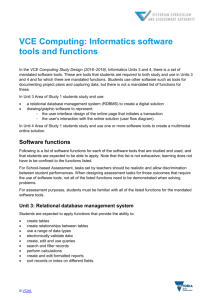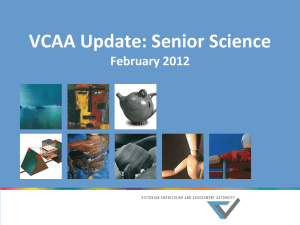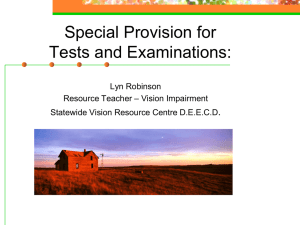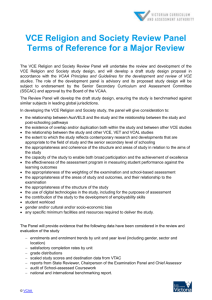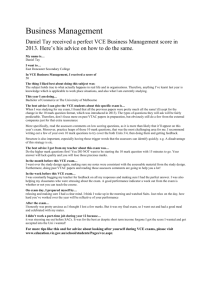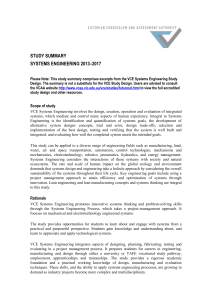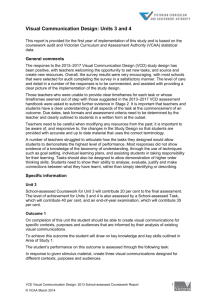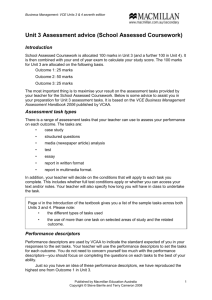Study Summary - Victorian Curriculum and Assessment Authority
advertisement
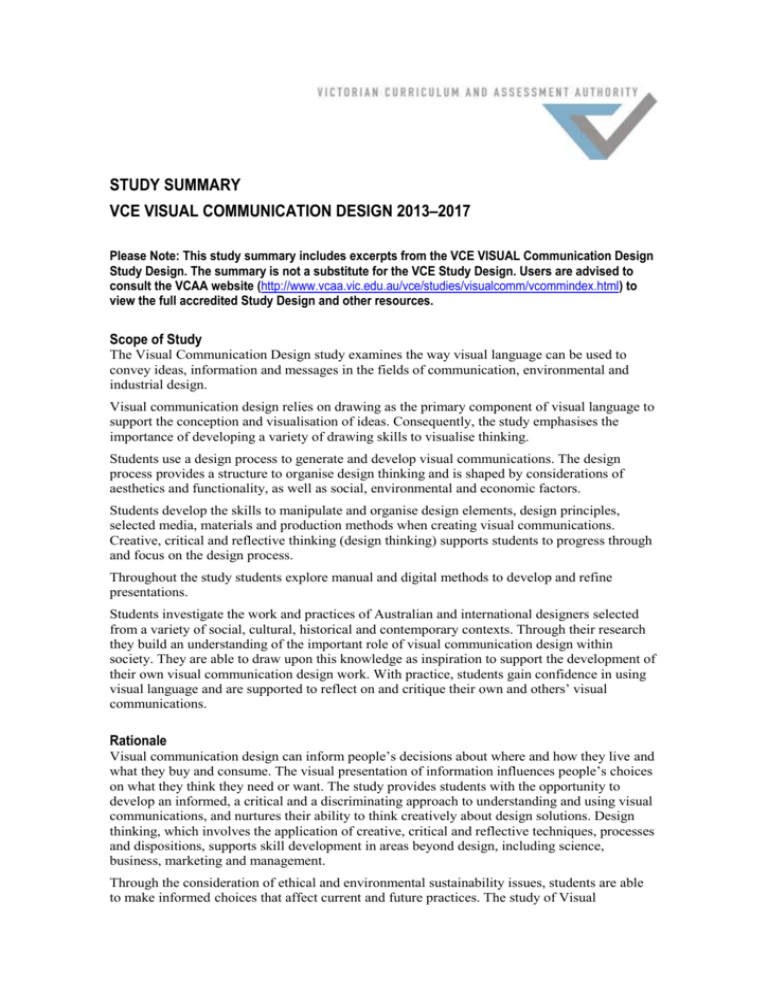
STUDY SUMMARY VCE VISUAL COMMUNICATION DESIGN 2013–2017 Please Note: This study summary includes excerpts from the VCE VISUAL Communication Design Study Design. The summary is not a substitute for the VCE Study Design. Users are advised to consult the VCAA website (http://www.vcaa.vic.edu.au/vce/studies/visualcomm/vcommindex.html) to view the full accredited Study Design and other resources. Scope of Study The Visual Communication Design study examines the way visual language can be used to convey ideas, information and messages in the fields of communication, environmental and industrial design. Visual communication design relies on drawing as the primary component of visual language to support the conception and visualisation of ideas. Consequently, the study emphasises the importance of developing a variety of drawing skills to visualise thinking. Students use a design process to generate and develop visual communications. The design process provides a structure to organise design thinking and is shaped by considerations of aesthetics and functionality, as well as social, environmental and economic factors. Students develop the skills to manipulate and organise design elements, design principles, selected media, materials and production methods when creating visual communications. Creative, critical and reflective thinking (design thinking) supports students to progress through and focus on the design process. Throughout the study students explore manual and digital methods to develop and refine presentations. Students investigate the work and practices of Australian and international designers selected from a variety of social, cultural, historical and contemporary contexts. Through their research they build an understanding of the important role of visual communication design within society. They are able to draw upon this knowledge as inspiration to support the development of their own visual communication design work. With practice, students gain confidence in using visual language and are supported to reflect on and critique their own and others’ visual communications. Rationale Visual communication design can inform people’s decisions about where and how they live and what they buy and consume. The visual presentation of information influences people’s choices on what they think they need or want. The study provides students with the opportunity to develop an informed, a critical and a discriminating approach to understanding and using visual communications, and nurtures their ability to think creatively about design solutions. Design thinking, which involves the application of creative, critical and reflective techniques, processes and dispositions, supports skill development in areas beyond design, including science, business, marketing and management. Through the consideration of ethical and environmental sustainability issues, students are able to make informed choices that affect current and future practices. The study of Visual VCE VISUAL COMMUNICATION DESIGN 2013–2017 STUDY SUMMARY Communication Design can provide pathways to training and tertiary study in design and design-related studies, including graphic design, industrial and architectural design and communication design. Structure The study is made up of four units: Unit 1: Introduction to visual communication design Unit 2: Applications of visual communication design Unit 3: Design thinking and practice Unit 4: Design development and presentation Each unit deals with specific content contained in areas of study and is designed to enable students to achieve a set of outcomes for that unit. Each outcome is described in terms of key knowledge and key skills. The Cross study specifications comprise study specific content applicable across Units 1 to 4. These specifications refer to definitions of visual communications, drawing methods and applications and the design process Entry There are no prerequisites for entry to Units 1, 2 and 3. Students must undertake Unit 3 prior to undertaking Unit 4. Units 1 to 4 are designed to a standard equivalent to the final two years of secondary education. Unit 1: Introduction to visual communication design This unit focuses on using visual language to communicate messages, ideas and concepts. This involves acquiring and applying design thinking skills as well as drawing skills to make messages, ideas and concepts visible and tangible. Students practise their ability to draw what they observe and they use visualisation drawing methods to explore their own ideas and concepts. Students develop an understanding of the importance of presentation drawings to clearly communicate their final visual communications. Through experimentation and through exploration of the relationship between design elements and design principles, students develop an understanding of how design elements and principles affect the visual message and the way information and ideas are read and perceived. Students review the contextual background of visual communication through an investigation of design styles. This research introduces students to the broader context of the place and purpose of design. In this unit students are introduced to three stages of the design process detailed on pages 12 and 13: researching designers, generating ideas and applying design knowledge and drawing skills to develop concepts. Unit 2: Applications of visual communication design This unit focuses on the application of visual communication design knowledge, design thinking skills and drawing methods to create visual communications to meet specific purposes in designated design fields. Students use presentation drawing methods that incorporate the use of technical drawing conventions to communicate information and ideas associated with the environmental or industrial fields of design. They investigate how typography and imagery are used in visual communication design. They apply design thinking skills when exploring ways in which images and type can be manipulated to communicate ideas and concepts in different ways in the communication design field. Students develop an understanding of the design process detailed on pages 12 and 13 as a means of organising their thinking about approaches to solving design problems and presenting ideas. In response to a brief, students engage in the stages of research, generation of ideas and development of concepts to create visual communications. ©VCAA 2012 2 VCE VISUAL COMMUNICATION DESIGN 2013–2017 STUDY SUMMARY Unit 3: Design thinking and practice In this unit students gain an understanding of the process designers employ to structure their thinking and communicate ideas with clients, target audiences, other designers and specialists. Through practical investigation and analysis of existing visual communications, students gain insight into how the selection of methods, media, materials and the application of design elements and design principles can create effective visual communications for specific audiences and purposes. They investigate and experiment with the use of manual and digital methods, media and materials to make informed decisions when selecting suitable approaches for the development of their own design ideas and concepts. Students use their research and analysis of visual communication designers to support the development of their own work. They establish a brief and apply design thinking skills through the design process detailed on pages 12 and 13. They identify and describe a client, two distinctly different needs of that client, and the purpose, target audience, context and constraints relevant to each need. Design from a variety of historical and contemporary design fields is considered by students to provide directions, themes or starting points for investigation and inspiration for their own work. Students use observational and visualisation drawings to generate a wide range of design ideas and apply design thinking strategies to organise and evaluate their ideas. The brief and investigation work underpin the developmental and refinement work undertaken in Unit 4. Unit 4: Design development and presentation The focus of this unit is the development of design concepts and two final presentations of visual communications to meet the requirements of the brief. This involves applying the design process twice to meet each of the stated needs. Having completed their brief and generated ideas in Unit 3, students continue the design process by developing and refining concepts for each need stated in the brief. They utilise a range of digital and manual two- and three-dimensional methods, media and materials. They investigate how the application of design elements and design principles creates different communication messages with their target audience. As students revisit stages to undertake further research or idea generation when developing and presenting their design solutions, they develop an understanding of the iterative nature of the design process. Ongoing reflection and evaluation of design solutions against the brief assists students with keeping their endeavours focused. Students refine and present two visual communications within the parameters of the brief. They reflect on the design process and the design decisions they took in the realisation of their ideas. They evaluate their visual communications and devise a pitch to communicate their design thinking and decision making to the client. Assessment Satisfactory Completion The award of satisfactory completion for a unit is based on a decision that the student has demonstrated achievement of the set of outcomes specified for the unit. This decision will be based on the teacher’s assessment of the student’s performance on assessment tasks designated for the unit. Levels of Achievement Units 1 and 2 Procedures for the assessment of levels of achievement in Units 1 and 2 are a matter for school decision. ©VCAA 2012 3 VCE VISUAL COMMUNICATION DESIGN 2013–2017 STUDY SUMMARY Units 3 and 4 The Victorian Curriculum and Assessment Authority will supervise the assessment of all students undertaking Units 3 and 4. In the study of Visual Communication Design Visual students’ level of achievement will be determined by School–assessed Coursework, a school– assessed Task and an end–of–year examination. Percentage contributions to the study score in Visual Communication Design are as follows: School–assessed Coursework: Unit 3 Outcomes 1 and 2 and Unit 4 Outcome 3 25 per cent School–assessed Task: Unit 3 Outcome 3 and Unit 4 Outcomes 1 and 2 40 per cent End-of-year examination: Units 3 and 4 35 per cent ©VCAA 2012 4



